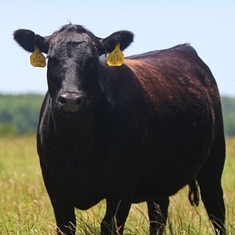Beef Farms
 Beef by the numbers....
Beef by the numbers....
- Beef farms in South Dakota: 13,928
- Number of beef cattle: 3.9 million head
- South Dakota national beef production rank: 5th
- Economic impact of beef industry: $2.2 billion
- Jobs created by beef industry: 12,571
- Business taxes paid by beef industry: $83.8 million
Beef Facts
Each year, South Dakota beef and dairy cattle consume an average of 19.4 million bushels of corn, 31,756 tons of soybean meal, and 3.6 million tons each of hay and silage.
In addition to meat products, beef by-products are included in many other items people utilize in everyday life such as: marshmallows, candies, gum, mayonnaise, yogurt, cookies and ice cream, leather, sporting goods, pet foods, shaving cream and shampoo, tires, asphalt, printing ink, lubricants, violin strings, toothpaste, glue, floor wax, fabric softeners and pharmaceutical products like insulin and glucagon.
Cattle spend most of their lives grazing on pasture, then spend 4 to 6 months in a feedlot.
Beef Quality Assurance (BQA) Program – The Beef Quality Assurance Program provides cattle farmers and rancher with the guidelines and training necessary to ensure animal health and wellbeing as well as provide a safe, quality product. BQA principals influence the management practices of more than 90 percent of cattle.
Proper livestock handling is important to ensure safety of the animal and people involved. Dr. Temple Grandin of Colorado State University works closely with beef packing plants to develop best practices for proper handling. Dr. Grandin also teaches facility managers how to conduct regular internal audits of plants. The American Meat Institute, which represents packing plants, reports that more than 90 percent of its members administer these self audits.
Beef producers and veterinarians take great care to use antibiotics judiciously to maintain healthy animals. The government supports this effort through regular testing and by mandating that no beef with antibiotic residues that exceed FDA standards be allowed in the food supply.
Source: South Dakota Department of Ag, United States Department of Agriculture and National Ag Statistics Service
